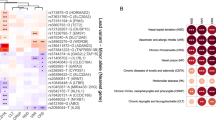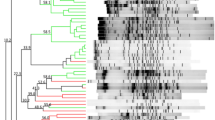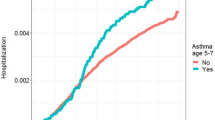Abstract
Type 1 diabetes (T1D) and allergic asthma are immune-mediated diseases. Pattern recognition receptors are proteins expressed by cells in the immune system to identify microbial pathogens and endogenous ligands. Toll-like receptors (TLRs) and CD14 are members of this family and could represent a molecular link between microbial infections and immune-mediated diseases. Diverging hypotheses regarding whether there exists a common or inverse genetic etiology behind these immune-mediated diseases have been presented. We aimed to test whether there exist common or inverse associations between polymorphisms in the pattern recognition receptors TLR2, TLR4 and CD14 and T1D and allergic asthma. Eighteen single nucleotide polymorphisms (SNPs) were genotyped in TLR2 (2), TLR4 (12) and CD14 (4) in 700 T1D children, 357 nuclear families with T1D children and 796 children from the ‘Environment and Childhood Asthma’ study. Allele and haplotype frequencies were analyzed in relation to diseases and in addition transmission disequilibrium test analyses were performed in the family material. Both T1D and allergic asthma were significantly associated with the TLR2 rs3804100 T allele and further associated with the haplotype including this SNP, possibly representing a susceptibility locus common for the two diseases. Neither TLR4 nor CD14 were associated with T1D or allergic asthma.
This is a preview of subscription content, access via your institution
Access options
Subscribe to this journal
Receive 6 digital issues and online access to articles
$119.00 per year
only $19.83 per issue
Buy this article
- Purchase on Springer Link
- Instant access to full article PDF
Prices may be subject to local taxes which are calculated during checkout
Similar content being viewed by others
References
Elias JA, Lee CG, Zheng T, Ma B, Homer RJ, Zhu Z . New insights into the pathogenesis of asthma. J Clin Invest 2003; 111: 291–297.
Cook DN, Pisetsky DS, Schwartz DA . Toll-like receptors in the pathogenesis of human disease. Nat Immunol 2004; 5: 975–979.
Marshak-Rothstein A . Toll-like receptors in systemic autoimmune disease. Nat Rev Immunol 2006; 6: 823–835.
Dabbagh K, Lewis DB . Toll-like receptors and T-helper-1/T-helper-2 responses. Curr Opin Infect Dis 2003; 16: 199–204.
Braun-Fahrlander C, Riedler J, Herz U, Eder W, Waser M, Grize L et al. Environmental exposure to endotoxin and its relation to asthma in school-age children. N Engl J Med 2002; 347: 869–877.
Sutmuller R, Garritsen A, Adema GJ . Regulatory T cells and Toll-like receptors: regulating the regulators. Ann Rheum Dis 2007; 66: 91–95.
Ni CN, Redmond HP . Regulatory T-cells and autoimmunity. J Surg Res 2006; 130: 124–135.
Kloting N, Kloting I, Jack RS . CD14 triggers autoimmune Type 1 diabetes in the NOD mouse. Diabetologia 2004; 47: 151–152.
Park Y, Park S, Yoo EKD . Association of the polymorphism for Toll-like receptor 2 with type 1 diabetes susceptibility. Ann NY Acad Sci 2004; 1037: 170–174.
Santin I, Bilbao J, De Nanclares GP, Calvo BH, Castãno L . No Association of TLR2 and TLR4 Polymorphisms with Type I Diabetes Mellitus in the Basque Population. Ann NY Acad Sci 2006; 1079: 268–272.
Radstake TR, Franke B, Hanssen S, Netea MG, Welsing P, Barrera P et al. The Toll-like receptor 4 Asp299Gly functional variant is associated with decreased rheumatoid arthritis disease susceptibility but does not influence disease severity and/or outcome. Arthritis Rheum 2004; 50: 999–1001.
Franchimont D, Vermeire S, El HH, Pierik M, Van SK, Gustot T et al. Deficient host-bacteria interactions in inflammatory bowel disease? The Toll-like receptor (TLR)-4 Asp299gly polymorphism is associated with Crohn's disease and ulcerative colitis. Gut 2004; 53: 987–992.
Santin I, Castellanos-Rubio A, Hualde I, Castano L, Vitoria JC, Bilbao JR . Toll-like receptor 4 (TLR4) gene polymorphisms in celiac disease. Tissue Antigens 2007; 70: 495–498.
Lamb R, Zeggini E, Thomson W, Donn R . Toll-like receptor 4 gene polymorphisms and susceptibility to juvenile idiopathic arthritis. Ann Rheum Dis 2005; 64: 767–769.
Reindl M, Lutterotti A, Ingram J, Schanda K, Gassner C, Deisenhammer F et al. Mutations in the gene for Toll-like receptor 4 and multiple sclerosis. Tissue Antigens 2003; 61: 85–88.
Eder W, Klimecki W, Yu L, von Mutius E, Riedler J, Braun-Fahrlander C et al. Toll-like receptor 2 as a major gene for asthma in children of European farmers. J Allergy Clin Immunol 2004; 113: 482–488.
Fageras BM, Hmani-Aifa M, Lindstrom A, Jenmalm MC, Mai XM, Nilsson L et al. A TLR4 polymorphism is associated with asthma and reduced lipopolysaccharide-induced interleukin-12(p70) responses in Swedish children. J Allergy Clin Immunol 2004; 114: 561–567.
Buckova D, Holla LI, Schuller M, Znojil V, Vacha J . Two CD14 promoter polymorphisms and atopic phenotypes in Czech patients with IgE-mediated allergy. Allergy 2003; 58: 1023–1026.
Smit LA, Bongers SI, Ruven HJ, Rijkers GT, Wouters IM, Heederik D et al. Atopy and new-onset asthma in young Danish farmers and CD14, TLR2, and TLR4 genetic polymorphisms: a nested case-control study. Clin Exp Allergy 2007; 37: 1602–1608.
Kabesch M, Hasemann K, Schickinger V, Tzotcheva I, Bohnert A, Carr D et al. A promoter polymorphism in the CD14 gene is associated with elevated levels of soluble CD14 but not with IgE or atopic diseases. Allergy 2004; 59: 520–525.
Sengler C, Haider A, Sommerfeld C, Lau S, Baldini M, Martinez F et al. Evaluation of the CD14 C-159T polymorphism in the German Multicenter Allergy Study cohort. Clin Exp Allergy 2003; 33: 166–169.
Stene LC, Joner G . Atopic disorders and risk of childhood-onset type 1 diabetes in individuals. Clin Exp Allergy 2004; 34: 201–206.
Munthe-Kaas MC, Carlsen KH, Helms PJ, Gerritsen J, Whyte M, Feijen M et al. CTLA-4 polymorphisms in allergy and asthma and the TH1/TH2 paradigm. J Allergy Clin Immunol 2004; 114: 280–287.
Eder W, Klimecki W, Yu L, von Mutius E, Riedler J, Braun-Fahrlander C et al. Toll-like receptor 2 as a major gene for asthma in children of European farmers. J Allergy Clin Immunol 2004; 113: 482–488.
Smit LA, Bongers SI, Ruven HJ, Rijkers GT, Wouters IM, Heederik D et al. Atopy and new-onset asthma in young Danish farmers and CD14, TLR2, and TLR4 genetic polymorphisms: a nested case-control study. Clin Exp Allergy 2007; 37: 1602–1608.
Martinez FD . CD14, endotoxin, and asthma risk: actions and interactions. Proc Am Thorac Soc 2007; 4: 221–225.
Yang IA, Savarimuthu S, Kim ST, Holloway JW, Bell SC, Fong KM . Gene-environmental interaction in asthma. Curr Opin Allergy Clin Immunol 2007; 7: 75–82.
Vercelli D . Advances in asthma and allergy genetics in 2007. J Allergy Clin Immunol 2008; 122: 267–271.
Stene LC, Nafstad P . Relation between occurrence of type 1 diabetes and asthma. Lancet 2001; 357: 607–608.
Simpson CR, Anderson WJ, Helms PJ, Taylor MW, Watson L, Prescott GJ et al. Coincidence of immune-mediated diseases driven by Th1 and Th2 subsets suggests a common aetiology. A population-based study using computerized general practice data. Clin Exp Allergy 2002; 32: 37–42.
Mattila PS, Tarkkanen J, Saxen H, Pitkaniemi J, Karvonen M, Tuomilehto J . Predisposition to atopic symptoms to inhaled antigens may protect from childhood type 1 diabetes. Diabetes Care 2002; 25: 865–868.
Cardwell CR, Shields MD, Carson DJ, Patterson CC . A meta-analysis of the association between childhood type 1 diabetes and atopic disease. Diabetes Care 2003; 26: 2568–2574.
The EURODIAB Substudy. Decreased prevalence of atopic diseases in children with diabetes. J Pediatr 2000; 137: 470–474.
Masoli M, Fabian D, Holt S, Beasley R . The global burden of asthma: executive summary of the GINA Dissemination Committee report. Allergy 2004; 59: 469–478.
Joner G, Søvik O . Increasing incidence of diabetes mellitus in Norwegian children 0–14 years of age 1973–1982. Diabetologia 1989; 32: 79–83.
Cardon LR, Bell JI . Association study designs for complex diseases. Nat Rev Genet 2001; 2: 91–99.
Kang ES, Lee J . Genotypic analysis of Asp299Gly and Thr399Ile polymorphism of Toll-like receptor 4 in systemic autoimmune diseases of Korean population. Rheumatol Int 2007; 27: 887–889.
Lodrup Carlsen KC, Haland G, Devulapalli CS, Munthe-Kaas M, Pettersen M, Granum B et al. Asthma in every fifth child in Oslo, Norway: a 10-year follow up of a birth cohort study. Allergy 2006; 61: 454–460.
EURODIAB ACE Study Group. Variation and trends in incidence of childhood diabetes in Europe. Lancet 2000; 355: 873–876.
Dreborg S, Frew A . Allergen standardization and skin tests. Allergy 1993; 48 (Suppl 14): 48S–82S.
Bjornvold M, Undlien DE, Joner G, hl-Jorgensen K, Njolstad PR, Akselsen HE et al. Joint effects of HLA, INS, PTPN22 and CTLA4 genes on the risk of type 1 diabetes. Diabetologia 2008; 51: 589–596.
The International HapMap consortium. The International HapMap Project. Nature 2003; 426: 789–796.
The International HapMap consortium. A haplotype map of the human genome. Nature 2005; 437: 1299–1320.
Barrett JC, Fry B, Maller J, Daly MJ . Haploview: analysis and visualization of LD and haplotype maps. Bioinformatics 2005; 21: 263–265.
Dudbridge F . Pedigree disequilibrium tests for multilocus haplotypes. Genet Epidemiol 2003; 25: 115–121.
Qin ZS, Niu T, Liu JS . Partition-ligation-expectation-maximization algorithm for haplotype inference with single-nucleotide polymorphisms. Am J Hum Genet 2002; 71: 1242–1247.
Ury HK, Fleiss JL . On approximate sample sizes for comparing two independent proportions with the use of Yates' correction. Biometrics 1980; 36: 347–351.
Acknowledgements
This work has been supported by The National Program for Research in Functional Genomics in Norway (FUGE), in The Research Council of Norway, University of Oslo, The Norwegian Diabetes Association, Eastern Norway Regional Health Authority, Western Norway Regional Health Authority and University of Bergen. We are grateful to all the children and their parents for participating in the study.
Author information
Authors and Affiliations
Corresponding author
Additional information
Supplementary Information accompanies the paper on Genes and Immunity website (http://www.nature.com/gene)
Supplementary information
Rights and permissions
About this article
Cite this article
Bjørnvold, M., Munthe-Kaas, M., Egeland, T. et al. A TLR2 polymorphism is associated with type 1 diabetes and allergic asthma. Genes Immun 10, 181–187 (2009). https://doi.org/10.1038/gene.2008.100
Received:
Revised:
Accepted:
Published:
Issue Date:
DOI: https://doi.org/10.1038/gene.2008.100
Keywords
This article is cited by
-
Maternal smoking during pregnancy and type 1 diabetes in the offspring: a nationwide register-based study with family-based designs
BMC Medicine (2022)
-
Type 1 diabetes and asthma: a systematic review and meta-analysis of observational studies
Endocrine (2022)
-
The association of inflammasome and TLR2 gene polymorphisms with susceptibility to tuberculosis in the Han Taiwanese population
Scientific Reports (2020)
-
Pplase of Dermatophagoides farinae promotes ovalbumin-induced airway allergy by modulating the functions of dendritic cells in a mouse model
Scientific Reports (2017)
-
A case–control study of innate immunity pathway gene polymorphisms in Puerto Ricans reveals association of toll-like receptor 2 +596 variant with asthma
BMC Pulmonary Medicine (2016)



